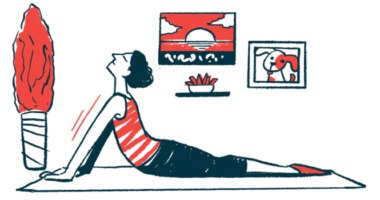Water Exercises Lead to Significant Gains for Men With AS in Study
6-week stretching or Pilates program helps ease pain and boost quality of life

Six weeks of water-based exercises — consisting of stretching or Pilates — led to significant reductions in pain and improvements in spine flexibility, functional capacity, and quality of life for men with ankylosing spondylitis (AS), according to a recent study in Iran.
While both types of exercise led to significant improvements, the stretching program led to more clinically meaningful changes in terms of life quality, walking capacity, and pain.
Based on the findings, “it is recommended that aquatic exercises be used by sports experts, therapists and physical therapists as the first part of a therapeutic exercise program for patients with AS,” the researchers wrote.
The study, “The effect of Aqua Stretching exercises and Pilates on pain, function and spine posture in patients with ankylosing spondylitis:a randomized controlled trial,” was published in BMC Sports Science, Medicine and Rehabilitation.
Natural resistance of water helps to strengthen muscles
Regular exercise is recommended as a component of the therapeutic regimens for AS patients.
It’s thought that the addition of physical activity to other AS treatments can facilitate gains in strength and flexibility, ease pain and fatigue, overall reducing the daily burden of symptoms.
Various types of physical activity have been shown to benefit AS patients, including stretching, yoga, and Pilates — a mind-body exercise approach that focuses primarily on the muscles in the center (core) of the body.
While most exercise programs for AS are conducted on land, water-based exercises may offer potential benefits as well.
“The natural resistance of the water strengthens the muscles,” the researchers wrote, also noting that the reduced stress on joints and bones when exercising in water could lead to greater reductions in pain.
Yet, few studies have investigated the effectiveness of water-based exercise for AS patients.
To learn more, the researchers conducted a clinical trial (IRCT20190426043377N3) to evaluate the effectiveness of six weeks of aquatic Pilates or stretching among men with AS at an institution in Iran.
A total of 51 men were enrolled and randomly assigned to undergo six weeks of water-based stretching, water-based Pilates, or no intervention (a control group).
Hour-long exercise sessions were conducted four times per week in a swimming pool. Pilates sessions consisted of a range of exercises such as breathing, balance, kicking, spine stretches, and twists.
The stretching intervention included various types of stretching performed across joint and muscle groups. Control participants continued their usual activities.
It is recommended that aquatic exercises be used by sports experts, therapists and physical therapists as the first part of a therapeutic exercise program for patients with AS.
Participants were assessed for changes in pain, functional capacity, spine posture, and quality of life at the study’s start and after the six-week intervention. Follow-up assessments were performed on 14 people in the Pilates group, 12 in the stretching group, and 14 in the control group.
Both stretching and Pilates groups saw comparable and significant functional improvements after six weeks of exercise, assessed by the Bath Ankylosing Spondylitis Functional Index and a 40-minute walking test (40-MWT).
Moreover, patients in both exercise groups experienced significant decreases in perceived pain intensity, increased spinal range of motion, and improved quality of life.
This was in contrast to patients in the control group, who did not see significant gains across any outcome measures. Changes in pain and functional improvements were statistically different between both exercise groups and the control group.
Stretching group found more clinically meaningful changes in pain, life quality
While all improvements were statistically similar between the two exercise groups, further analyses demonstrated that the changes in the stretching group were more clinically meaningful for pain, life quality, and the 40-MWT.
“This may be because stretching exercises improve muscle stiffness in these patients, followed by flexibility, and reduce swelling and pain,” the researchers wrote.
Overall, the findings demonstrate the potential benefits of water-based exercises for men with AS.
Limitations of the study included its small sample size, the lack of inclusion of female patients due to local laws, and the lack of land-based exercise groups for comparison.
Randomized trials to compare water- and land-based exercises “should be encouraged to determine the cumulative or additive benefits of these different environments on the physical and well-being of participants with AS,” the researchers wrote.
Studies with longer-term follow-up are also needed, the team noted.








